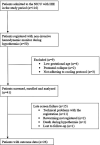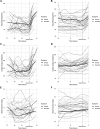Time series analysis of non-invasive hemodynamic monitoring data in neonates with hypoxic-ischemic encephalopathy
- PMID: 37033181
- PMCID: PMC10076839
- DOI: 10.3389/fped.2023.1112959
Time series analysis of non-invasive hemodynamic monitoring data in neonates with hypoxic-ischemic encephalopathy
Abstract
Background and aims: Hemodynamic instability is common in neonates with hypoxic-ischemic encephalopathy (HIE) undergoing therapeutic hypothermia (TH). Rewarming is a critical period and non-invasive circulatory monitoring may help guide cardiovascular supportive therapy. The aim of the study was to provide a comprehensive analysis of cardiac function parameters during TH and its relation to neurodevelopmental outcome.
Methods: In a prospective, observational study, 26 neonates with moderate-severe HIE were enrolled, born between 2016 and 2019. A hemodynamic monitor based on electrical velocimetry (ICON, Osypka Medical GmbH, Berlin, Germany) was used. Heart rate (HR), stroke volume (SV), cardiac output (CO) data were recorded continuously throughout TH and rewarming. Neurological outcome was assessed at 2 years of age using the Bayley Scales of Infant Development II. edition. Favorable outcome was defined as >70 points on both the psychomotor and mental scales. Time-series analysis was used and features of cardiac function were described to perform logistic regression modeling for outcome prediction.
Results: Fourteen (54%) patients had favorable and 12 (46%) had adverse outcome. Data collection started from median [IQR] of 11.8 [7.0; 24.3] hours (h) of life and lasted until 84.0. [81.8; 87.0] h. During TH, the mean HR of the favorable outcome group was significantly lower than that of the adverse outcome group (86 ± 13/min vs. 104 ± 18/min, p = 0.01). During rewarming HR increased similarly in both groups. SV was unaffected by rewarming, and showed a slowly increasing trend. SV of the favorable outcome group was significantly higher compared to the adverse outcome group (1.55 ± 0.23 ml/kg vs. 1.29 ± 0.30 ml/kg, p = 0.035). In line with this, CO was similar in both groups (136 ± 27 ml/kg/min vs. 134 ± 36 ml/kg/min), and a significant 25% increase in CO was observed during rewarming. Based on multiple regression modeling, HR during TH was independently associated with neurological outcome (p = 0.023).
Conclusion: Based on continuous hemodynamic monitoring, patients with adverse outcome have lower SV and higher HR to achieve similar CO to patients with favorable outcome during TH. HR during hypothermia is independently associated with the neurodevelopmental outcome.
Keywords: asphyxia; bioimpedance; electrical velocimetry (EV); hemodynamic monitoring; hypoxic ischaemic encehalopathy; neonates.
© 2023 Balog, Vatai, Kovacs, Szabo, Szabo and Jermendy.
Conflict of interest statement
The authors declare that the research was conducted in the absence of any commercial or financial relationships that could be construed as a potential conflict of interest.
Figures







Similar articles
-
Hemodynamic Changes During Rewarming Phase of Whole-Body Hypothermia Therapy in Neonates with Hypoxic-Ischemic Encephalopathy.J Pediatr. 2018 Jun;197:68-74.e2. doi: 10.1016/j.jpeds.2018.01.067. Epub 2018 Mar 20. J Pediatr. 2018. PMID: 29571928
-
Non-invasive continuous cardiac output monitoring in infants with hypoxic ischaemic encephalopathy.J Perinatol. 2022 Dec;42(12):1622-1629. doi: 10.1038/s41372-022-01495-2. Epub 2022 Sep 2. J Perinatol. 2022. PMID: 36056257 Free PMC article.
-
Active cooling temperature required to achieve therapeutic hypothermia correlates with short-term outcome in neonatal hypoxic-ischaemic encephalopathy.J Physiol. 2020 Jan;598(2):415-424. doi: 10.1113/JP278790. Epub 2020 Jan 2. J Physiol. 2020. PMID: 31777079
-
Therapeutic hypothermia for neonates with hypoxic ischemic encephalopathy.Pediatr Neonatol. 2017 Dec;58(6):475-483. doi: 10.1016/j.pedneo.2016.11.001. Epub 2017 Mar 27. Pediatr Neonatol. 2017. PMID: 28416250 Review.
-
Hemodynamic changes and evaluation during hypoxic-ischemic encephalopathy and therapeutic hypothermia.Early Hum Dev. 2022 Apr;167:105563. doi: 10.1016/j.earlhumdev.2022.105563. Epub 2022 Feb 26. Early Hum Dev. 2022. PMID: 35248984 Review.
Cited by
-
Association between cardiovascular care and neurodevelopmental outcomes in infants with neonatal encephalopathy and hemodynamic instability.J Perinatol. 2025 Aug;45(8):1073-1080. doi: 10.1038/s41372-025-02230-3. Epub 2025 Feb 17. J Perinatol. 2025. PMID: 39962327
-
A recommendation for the use of electrical biosensing technology in neonatology.Pediatr Res. 2025 Feb;97(2):510-523. doi: 10.1038/s41390-024-03369-z. Epub 2024 Jul 8. Pediatr Res. 2025. PMID: 38977797 Free PMC article.
References
LinkOut - more resources
Full Text Sources

